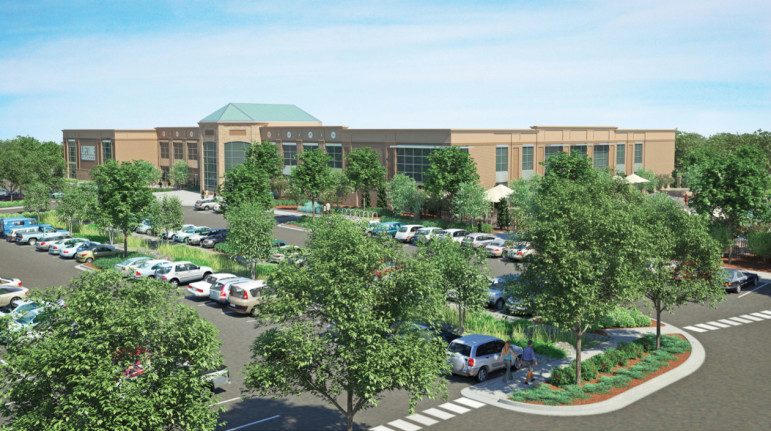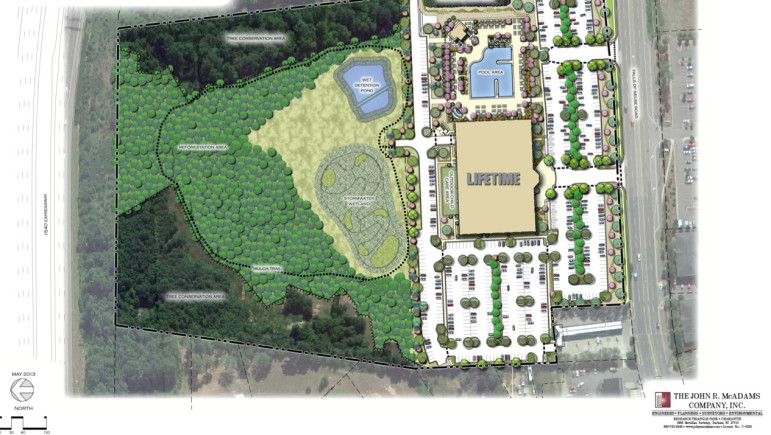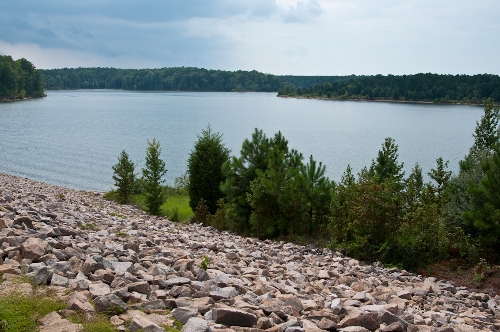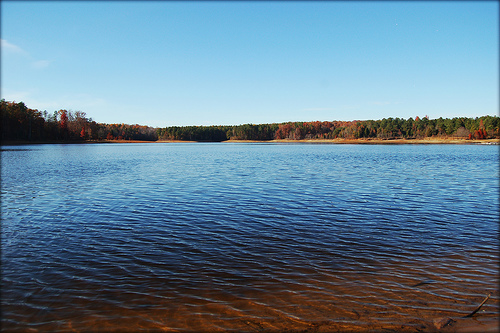Raleigh City Councilors gave a preliminary thumbs down to a controversial rezoning in the Falls Lake watershed, but the conversation continues on development in sensitive areas.
As technology seems to make environmentally friendly building in such areas a possibility, the City is faced with the challenge of starting down a path that could lead to more harm than good. The watersheds are the lands surrounding the creeks, streams and rivers that supply Raleigh’s drinking water, and traditionally these areas have limited development. New stormwater management technology could provide a way to increase water quality and allow more intense development, but until more research is done, city officials are staying away from setting any sort of precedent.
A Ray Road rezoning is the most recent case of builders who want to increase development in the watershed. Developers wanted to increase the density from one house per acre to 1.5 houses per acre in a 17-acre subdivision just north of Strickland Road in North Raleigh.
At their Feb. 18 meeting, Councilors upheld the Planning Commission’s recommendation to deny the rezoning, but city law states that a public hearing must be held before Councilors can formally deny the request. That public hearing will take place in April.
Not all watershed rezoning cases are universally denied. Last May, Councilors approved a rezoning off of Falls of Neuse Road just south of Interstate 540 that allowed the construction of a Lifetime Fitness gym in the watershed.
As Raleigh continues to grow, city officials are feeling the pressure to continue to expand into the watershed.

Provided by Lifetime Fitness.
A rendering of Lifetime Fitness.
Where the Rain Goes
In Raleigh, development in the watershed is limited to low-density residential, typically one house per acre. Some commercial is allowed, but it’s limited to low-intensity development such as public schools, libraries and churches.
With development comes impervious surfaces — those that water can’t penetrate, like a house, a patio or a driveway. As development increases in an area, so does the associated impervious surface.
When rainfall hits and travels across impervious surfaces, it takes with it all the dirt, sediment, oil, and garbage on top of that surface.
The rainwater, now laden with pollutants, flows into streams and creeks, and eventually makes its way to someone’s water supply. Raleigh primarily gets its drinking water from Falls Lake and Lake Benson.
The areas in the watershed are especially sensitive to this kind of runoff.

Ariella Monti
Stormwater flows from a gutter system along Hargett Street in downtown Raleigh.
The city is responsible for providing water to not only city residents, but residents in many of the surrounding towns including Garner, Wake Forest, Wendell and Zebulon. The more polluted the water is when it goes into the treatment plant, the more money it costs to make it drinkable.
The area’s continued and rapid growth continues to put strain on water resources and water quality. Elected officials, government staffers and nonprofit groups are already questioning how to provide water for the area’s anticipated growth.
“I am not anti-development in any stretch of the imagination, or anti-growth,” said Raleigh native and Upper Neuse Riverkeeper Matthew Starr. “But we have to continue to grow this area of North Carolina in a way that’s not a detriment to our environment.”
Starr said he was comfortable with the Lifetime Fitness project because its design included an array of stormwater devices, also called best management practices.
He was less comfortable, however, with the Ray Road rezoning because initially it didn’t include any conditions that would mitigate stormwater.
Later in the process, the developers included conditions that would limit density to 1.48 units per acre, limit impervious surface to 24 percent of the total property area and onsite stormwater management devices would limit nitrogen and phosphorous runoff.
“You have to very much be concerned about setting precedent,” Starr said. “Not every developer is going to care about environmental impacts.”

Provided by Lifetime Fitness.
A map of the area around the Lifetime Fitness built in the watershed.
The Problem with Precedent
Protecting water quality is undoubtedly a regional issue. Even if pollutants don’t end up in Raleigh’s water supply, they could end up in someone else’s.
Raleigh officials work closely with their neighbors in Durham and Wake counties, but the fear of setting a precedent is on the forefront of everyone’s minds.
The Ray Road rezoning, for example, would have increased density — albeit slightly — in the watershed and included few conditions that would lessen the stormwater impact. An approval could open the door to more developers or property owners rezoning their watershed properties.
Councilors, and members of the Planning Commission who first review the cases, would have to justify why one case was approved but not another.
“Deviations can turn into a defacto new policy,” said Ken Bowers of the City’s Planning Department. “But the question is, do you want the policy change to be done on an ad hoc basis or as the result of careful consideration and study?”
Not only are property owners watching the Council for action, but other municipalities are as well.
Setting a precedent was a major conversation piece in both the Lifetime Fitness and Ray Road rezoning cases. Approving cases with high-performance standards would force developers to amp up their stormwater management plans in order to guarantee a green light from Councilors.
Density Versus Performance-Based Standards
Raleigh has always had a density-based standard for keeping watershed development in check. Generally, commercial development is prohibited because it comes with a lot of impervious surface, mostly in the form of parking lots.
As it stands, the City’s policy is to keep commercial development out of the watershed, and keep residential subdivisions at a low density. As the provider for water and sewer for the area, City officials have also kept expansion of the utility lines to areas of the watershed to a minimum.
In November 2012, Councilors denied a request by the Wake Forest Fire Department to extend sanitary sewer into the watershed so the department could build a new fire station. Councilors did, however, approve running water lines to the property. Councilors later approved running the sewer lines following an onsite inspection.
“From several cases over the last 20 years in Swift Creek and Falls Lake watersheds it’s been noted by councils of the past that if water and sewer was available there was significant pressures from property owners to change the zoning,” said Assistant Public Utilities Director Kenny Waldroup.

Jennifer Wig/Raleigh Public Record
File: Falls Lake near the dam.
“We have to look at the impacts of making a number of similar decisions over time,” Bowers said. “One of the reasons why you have a policy is so you’re not making decisions on a case-by-case basis and there’s some uniformity to it.”
Lifetime Fitness, after about six months of discussion, was ultimately approved because its location allowed for the water to be pumped out of the watershed.
Originally, Lifetime Fitness proposed a series of high-tech stormwater devices that would have been located on two-thirds of the property. The property would have been monitored and studied by researchers at N.C. State for three years, much like the Whole Foods development on Six Forks Road.
From a stormwater standpoint, representatives said Lifetime Fitness was supposed to be invisible. But, without empirical data that the stormwater management systems would improve water quality, Councilors opted to pump the water out of the watershed.
The city can ask Lifetime Fitness during the next 15 years to add the low-impact stormwater devices once they’ve been proven to work in other areas. Waldroup said staff is researching the merits of using high-performing stormwater devices as a substitute to limiting density or utility expansion.
“Are there other opportunities to protect water supply and water quality while allowing a change in density, impervious surface and urbanization?” Waldroup said of the research.
Asked if he believed that stormwater controls have reached a level of sophistication that they would actually increase water quality if implemented correctly, Waldroup replied, “We haven’t received enough information to form an opinion.”
Pressure from Within
During discussions surrounding the Ray Road rezoning case, Planning Commission members agreed that it was up to City Councilors to begin having a larger policy discussion about watershed development.
During a Planning Commission committee meeting last month, members discussed the problems with handling each of these cases as they come.
“There is just a fundamental policy issue about doing things case by case,” said Commissioner John Buxton. “You can always find individual things that are right and good, and you can stand by, but that doesn’t make citywide development easier.”
Like many of the Commissioners, Buxton, didn’t have a problem with the project itself, but was unsure of the impact it would have on future cases.
Rodney Swink, one of the Commission’s newer appointees, said he thinks some developers might cherry-pick standards and get away with it.
“I’m concerned about us opening the door to someone else who might see this but might not understand the threshold,” he said.
Ultimately, Commissioners voted 6 to 3, recommending the City Council deny the case.
“This is not a policy that we are going to make by voting for or against this,” said Commissioner Joe Lyle, who voted against denial. “I believe we need to have a stance on this issue which makes, moving to Council, a stronger point than denial.”
Mayor Nancy McFarlane said that the question always comes down to precedent.
“Our policy is that we’re not building commercial in the watershed,” she said. “ And we’re not changing standards for residential development.”
The Lifetime Fitness site, she said, had the ability to pump water out of the watershed and was somewhat of a prototype for performance-based standards for development. It’s one thing to show a model of the effects a project will have on a site. It’s another, she said, to make sure it actually works.
When it comes to residential watershed development, McFarlane said she’s having staff look at the environmental effects of septic systems versus running water and sewer.
“If we have the same density, and the same amount of impervious surface, is it better or worse for the environment to have septic or water?”
In the end, the issue comes down to protecting the water supply for Raleigh’s current and future residents. Those costs continue to rise.
“The numbers to clean the water coming out of Falls Lake are going up all the time,” McFarlane said. “Anything we can do to protect that actually pays off for the taxpayers.”
